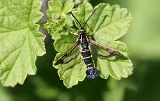
Synanthedon tipuliformis
Encyclopedia
Synanthedon tipuliformis, known as the Currant Clearwing, is a moth
of the family Sesiidae
. It is endemic to the Palearctic ecozone, but is an invasive species in the Nearctic ecozone and the Australasia ecozone
.
 The wingspan
The wingspan
is 17–20 mm (0.669291338582677–0.78740157480315 ). The moth flies from April to July depending on the location.
The larvae feed on Ribes
species, including Ribes nigrum, Ribes rubrum and Ribes uva-crispa. They bore into the stems to feed.
Moth
A moth is an insect closely related to the butterfly, both being of the order Lepidoptera. Moths form the majority of this order; there are thought to be 150,000 to 250,000 different species of moth , with thousands of species yet to be described...
of the family Sesiidae
Sesiidae
The Sesiidae or clearwing moths are family of the Lepidoptera in which the wings partially have hardly any of the normal lepidopteran scales, leaving them transparent. The bodies are generally striped with yellow, red or white, sometimes very brightly, and they have simple antennae...
. It is endemic to the Palearctic ecozone, but is an invasive species in the Nearctic ecozone and the Australasia ecozone
Australasia ecozone
The Australasian zone is an ecological region that is coincident, but not synonymous , with the geographic region of Australasia...
.

Wingspan
The wingspan of an airplane or a bird, is the distance from one wingtip to the other wingtip. For example, the Boeing 777 has a wingspan of about ; and a Wandering Albatross caught in 1965 had a wingspan of , the official record for a living bird.The term wingspan, more technically extent, is...
is 17–20 mm (0.669291338582677–0.78740157480315 ). The moth flies from April to July depending on the location.
The larvae feed on Ribes
Ribes
Ribes is a genus of about 150 species of flowering plants native throughout the temperate regions of the Northern Hemisphere. It is usually treated as the only genus in the family Grossulariaceae. Seven subgenera are recognized....
species, including Ribes nigrum, Ribes rubrum and Ribes uva-crispa. They bore into the stems to feed.

